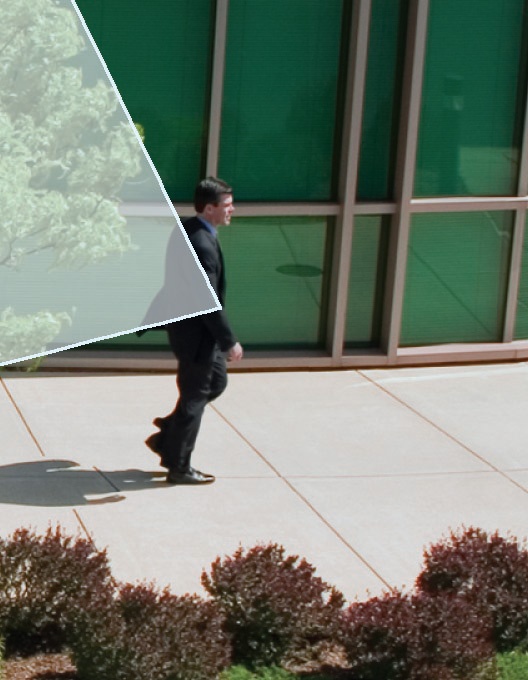Bosch: high-speed Autodome systems
Bosch: high-speed Autodome systems. Much has been written about Autodome CCTV camera systems since their introduction in the early 1990s. In addition to Autodome functionality, mos...


Bosch: high-speed Autodome systems. Much has been written about Autodome CCTV camera systems since their introduction in the early 1990s. In addition to Autodome functionality, most articles have focussed on developments in the speed and accuracy of the positioning systems, image quality and zoom functions determining the level of detail that can be seen. Some of the newest advances, however, in flexibility, communications and intelligence are taking high-speed Autodome camera systems into interesting directions. An article by Ad Biemans from Bosch, whose AutoDome has won the second prize of the GIT SICHERHEIT Award.
Until the industry moves to economically feasible HDTV or megapixel IP cameras, the resolution realistically attainable in a conventional PAL or NTSC colour camera is limited to around 540 TV Lines. There may be slight improvements, but dramatic improvements are unlikely without a major technology leap to HDTV or megapixel imaging. Similarly, in terms of sensitivity, cameras are approaching the practical limit, even when using the latest sensor and noise-reduction technologies.
Moreover, recent advances in zoom lenses have increased the zoom range dramatically. But in general, the gains are at the wide-angle end of the range rather than at the telephoto end where zooming-in close would be most valuable. It is often surprising that a typical 18x lens available in Autodomes can zoom-in almost as far as a 26x or 30x zoom lens.
Likewise, incremental pan and tilt speed improvements may be possible, but is reaching the required scene in onethird of a second instead of one-half of a second really of much practical value? So while manufacturers work on breakthrough technical and functional enhancements in the fundamentals, users are demanding greater improvements in other areas, notably: system flexibility, communications and on-board intelligence – areas in which companies such as Bosch Security Systems are also focussing considerable attention.
Built-in System Flexibility
The use of Autodomes has moved rapidly from traditional retail and casino environments to a much wider range of applications. Autodomes are now used in extremely harsh environments, such as traffic, transportation and industrial facilities, as well as for perimeter protection at hospitals and other commercial buildings. As a result, surveillance encroaches on neighbouring houses, schoolyards and other properties. It is therefore absolutely critical (and in some cases actually required by law) that these areas are protected from observation.
In the early days of privacy masking, only a few crude rectangular blanked areas could be defined within the camera. Now users demand the ability to define more than 20 precise areas that are accurately tracked and masked when the Autodome pans, tilts or zooms the view. What’s more, to ensure privacy without hiding critical surveillance points from view, these areas are often irregularly shaped.
Nowadays Autodomes are also expected to operate effectively in relatively inclement conditions or in areas where mechanical stability may present problems. Autodomes placed outdoors require heaters and blowers that efficiently direct the airflow to keep the bubble clear, even at temperatures as low as –60°C. For Autodomes operating in hot climates, a shield that allows a flow of air over the Autodome and protects the camera from direct sun is a prerequisite. And weather is not the only challenge. Physical damage can come from misuse or attack unless special precautions are taken, such as ruggedised housings and bubbles that can literally withstand an attack from a baseball bat.
Communications
The vast majority of systems installed today still use analogue encoding techniques and coax, UTP or fibre-optic media. A modern Autodome should accommodate all these communications options, as well as offering embedded IP transmission to allow the Autodome to be viewed, controlled and configured over TCP/IP networks. The built-in encoder should be capable of providing video quality equal to that in the analogue world. The generally accepted standard for image resolution is D1 or 4 CIF (704x480 NTSC, or 704x576 PAL).
The latest encoders utilise MPEG-4 compression and can deliver 25 or 30 images per second at 4CIF resolution. Some encoders, moreover, provide the ability to stream two different video streams. One stream is normally used to deliver high-resolution full image rates for live viewing and alarm recording. The second stream is used for timelapse recording or viewing over networks with severely restricted bandwidth such as ADSL lines. The best systems will actually have tri-streaming capability and include an additional JPEG stream to, for example, allow integration to multiple systems or send images to an FTP server on alarm.
A further advantage of IP transmission is that, with no additional cabling, audio can be transmitted along with the video, allowing the operator to see and hear what is happening at the remote site. Autodome control, configuration and firmware upgrading over the video cable provides obvious advantages whether using analogue or IP communications. In the past, intelligent video applications were hosted on expensive, centralised PC-based systems.
Now this intelligence is moving into the camera itself. This eliminates the need for large, costly servers and specialised software. And as more and more intelligence moves into the systems, users are increasingly demanding Autodomes that allow remote upgrades, adding new features as they become available and eliminating disruption to operations and the expense of a site visit. Although the CCTV world is rapidly moving into the digital age, spurred by the ubiquitous connectivity of IP communications, there is still a huge installed base of analogue transmission and control systems that will take years – some say decades – to completely transition into digital.
It’s therefore critical that Autodome systems be capable of hybrid operation – the ability to stream IP and analogue video simultaneously. This ensures compatibility with existing analogue systems and provides a migration path to fully digital CCTV systems in the future.
On-board Intelligence
The need to limit expensive bandwidth and storage is, moreover, accelerating the trend towards adding video intelligence to CCTV systems. The use of intelligent systems to filter out unwanted or unnecessary transmissions or recordings has been the norm for many years in multiplexers and digital recorders. And it is now almost impossible to buy a digital recorder without some form of video motion detection (VMD) that can trigger an alarm or record at a better frame rate or image quality when something is really happening. However, most video motion detection systems work only with fixed cameras.
So moving VMD intelligence into a high-speed Autodome system offers both new challenges and new opportunities. The obvious challenge is that the camera view or picture regularly changes. That is the purpose of an Autodome system, after all, but it means that it’s difficult to detect motion reliably in a moving scene. However, the vast majority of Autodomes, especially in larger systems, operate on a programmed tour of only a few preset shots. So newer systems can be programmed to have different VMD configurations for each preset shot and, with an eye to digital recording and transmission costs, can even freeze the frame during the transition between shots to minimise the data transmitted and stored at these times.
Imagine an Autodome installed at the corner of a distribution facility site. Preset camera views, or shots, can be set for the perimeter fence, the key entrances to the building, and the loading bays. Each scene has its own individual VMD configuration, providing built-in multichannel VMD functionality right in the Autodome camera. But tapping the Autodome’s intelligence beyond that point holds the biggest benefit. What the system does after motion is detected is just as important as the detection of motion itself.
Rather than rely solely on the transmission of the alarm to a remote CCTV controller where action begins, a smart modern Autodome will embody an intelligent response algorithm combining a number of input conditions that activate a response sequence. For example, a VMD event could be linked with other alarm inputs, such as a fence detection system, to initiate an alarm signal over the network, switch on the lights, trigger increased frame rate recording and begin tracking the object that was detected. This is where the combination of an Autodome camera and intelligent video technology comes into its own.
Pioneered by Bosch, automatic tracking using embedded video intelligence allows the Autodome to follow and record intruders even when a site is unattended. However, most outdoor camera views contain areas with non-relevant motion such as footpaths or roads outside the perimeter, and trees or plants that move in the wind. The more advanced motion-tracking systems such as that developed by Bosch therefore include the ability to place “virtual masks” over areas where non-relevant motion is expected, and to allow temporary occlusion of the object or person being tracked.
So while still operating best on relatively empty scenes, the newest tracking systems allow for accurate detection and successful tracking even in complex outdoor environments. With a modern intelligent Autodome system, it is therefore possible to detect motion in a number of different views, trigger an alarm if necessary, establish a transmission link to a central monitoring station and track an intruder — all without any operator intervention.
Easy Installation and Maintenance
With an eye to the future, any business-savvy user will insist on an assurance that the investment is safe and “future proofed”. A modular design that allows simple and fast hardware and firmware updates is therefore essential. In this respect, the latest Dome systems, such as the Bosch AutoDome, employ a system of interchangeable modules that allows users to quickly and cost-effectively add advanced functionality such as TCP/IP connectivity and object tracking, or to upgrade to the latest camera optics technology without swapping out the entire system.
An Expanding Role in CCTV
High-speed Autodomes have come a very long way since the early days when a camera and zoom lens were mounted on a conventional pan/tilt unit and simply housed in a large Autodomed enclosure. Today, units are smaller and have much higher performance, thanks to countless technological advances that have been adapted for the security industry.
And with the continuing advances in technology, high-speed Autodomes are destined to play an increasingly important role in modern analogue or networkbased CCTV systems.
Ad Biemans
Contact:
Bosch GmbH,
Ottobrunn, Germany
Tel.: +49 89 6290 1647
Fax: +49 89 6290 2816 47
info.service@de.bosch.com
www.bosch.com
most read

Integrated and Futureproof: Traka’s Next Chapter
Interview with Stefni Oliver on Traka’s Vision for the Future


Machine & plant safety: The winners of category A at the GIT SECURITY AWARD 2026
GIT SECURITY AWARD 2026: Machine & plant safety - an overview of the most innovative solutions

The Benefits of AI-based Video Surveillance Solutions for Sports Venues
Dallmeier Interview: Artificial intelligence Makes Stadiums Smarter

Is Your Venue Ready for Martyn’s Law?
Martyn’s Law demands stronger security by 2027. Is your venue prepared to protect and respond?








